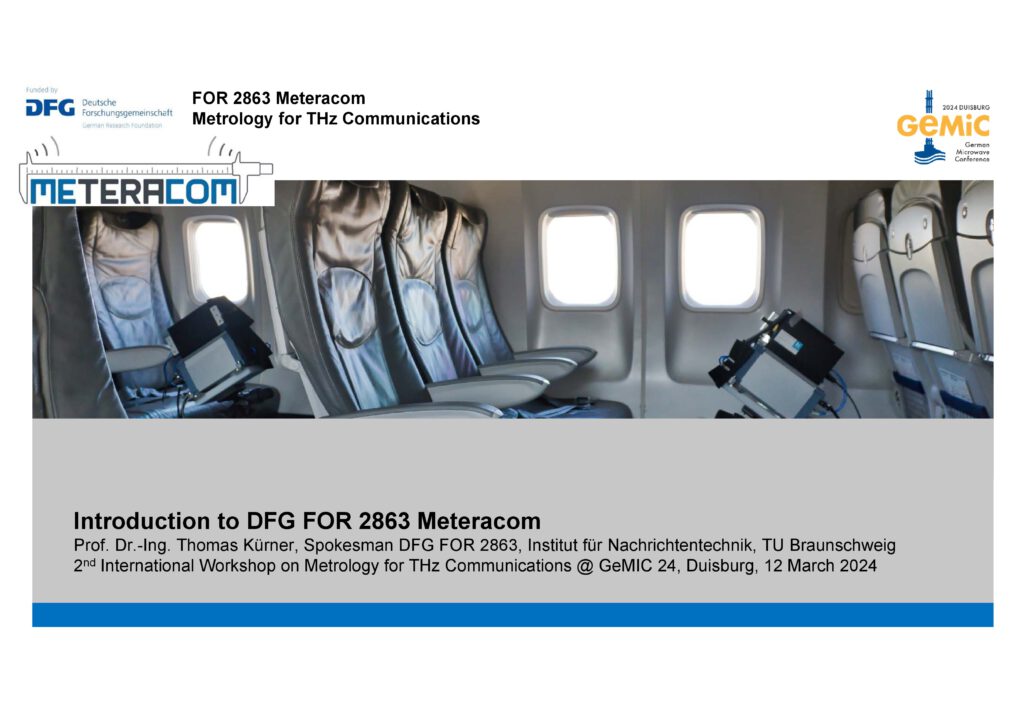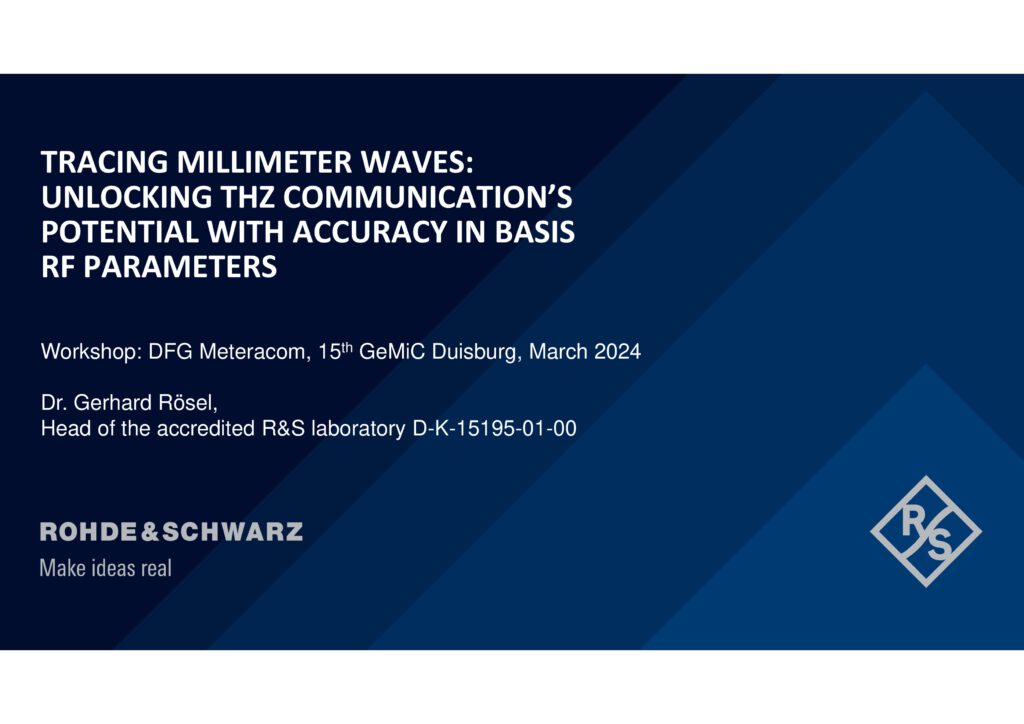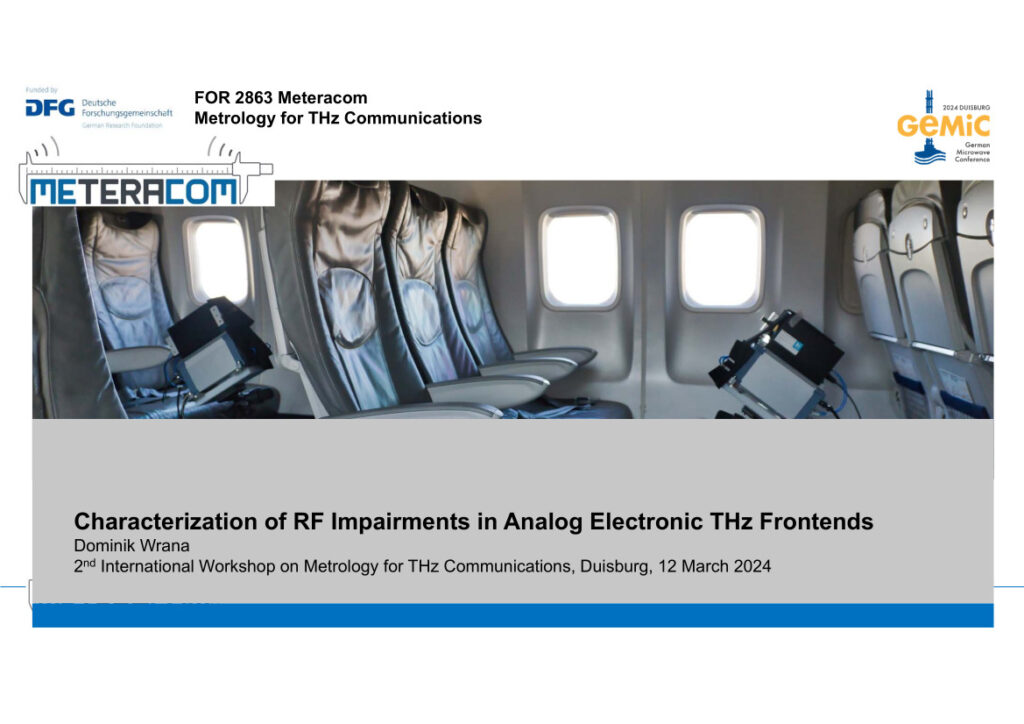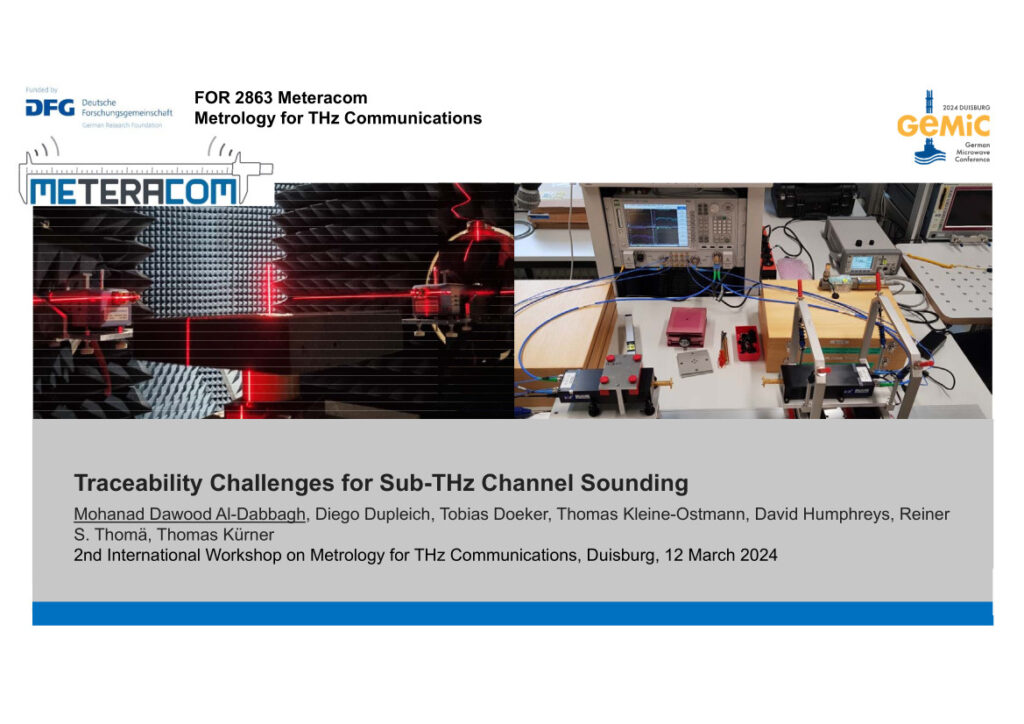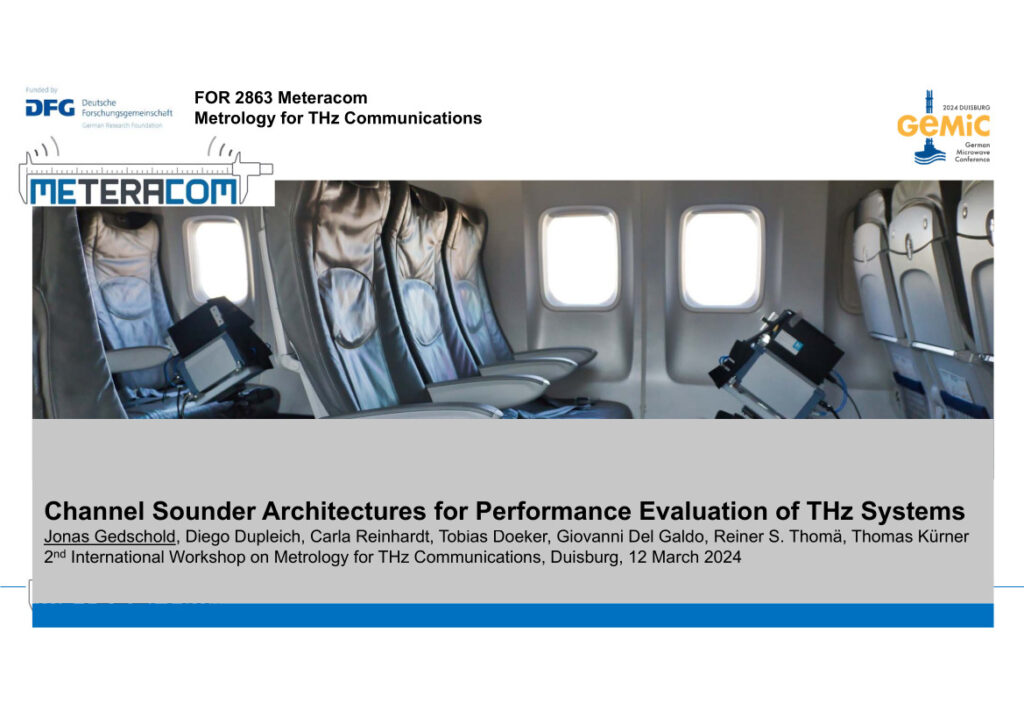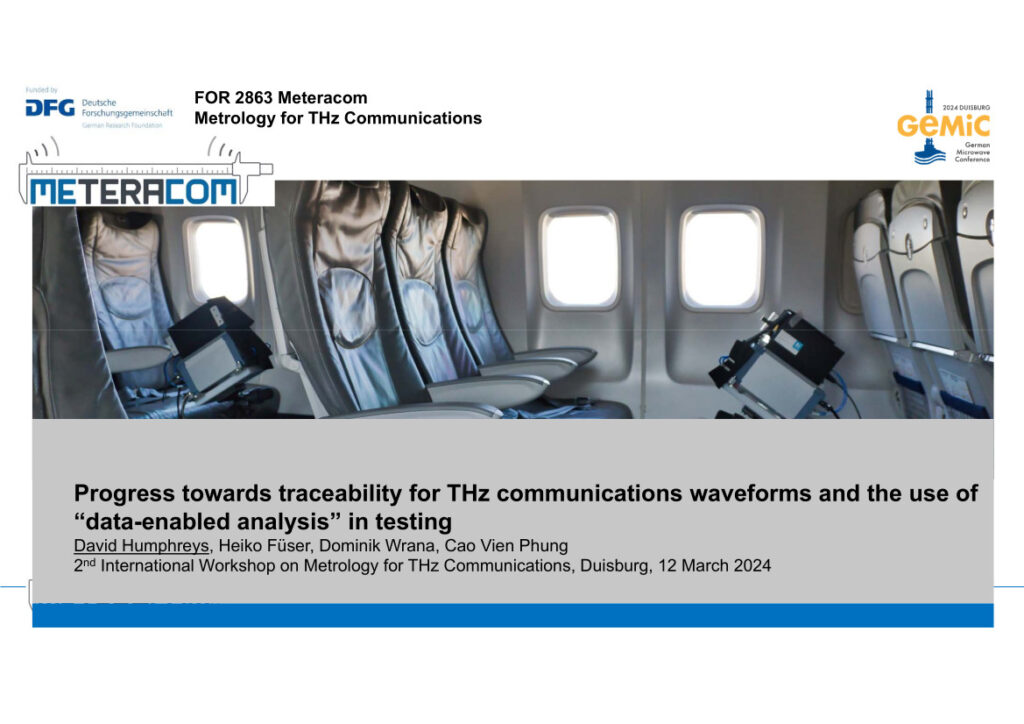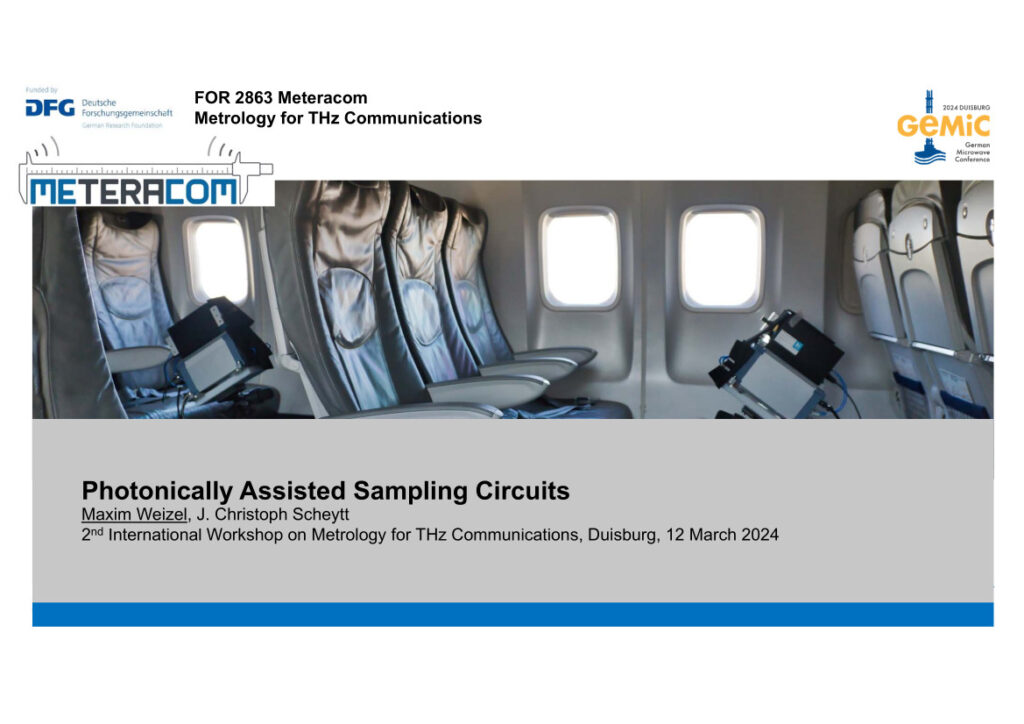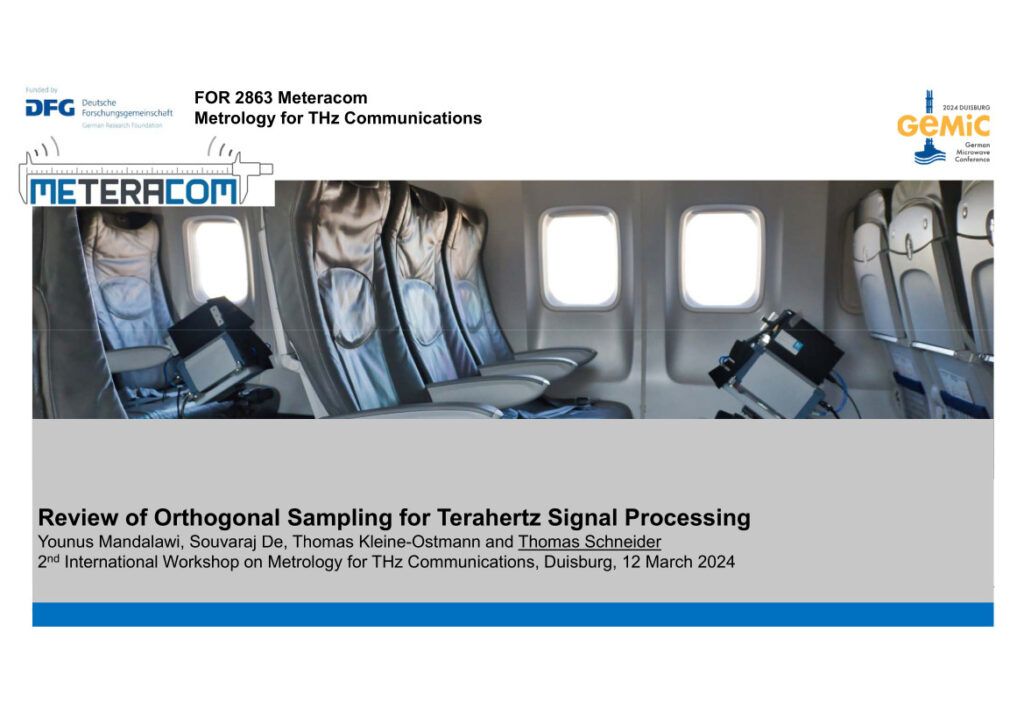In March 2024, the Meteracom consortium will present its work during the Workshop at GeMiC in Duisburg, Germany.
Meteracom Workshop
08:40 – 08:50
Thomas Kürner, Technische Universität Braunschweig, Germany:
Introduction to DFG FOR 2863 Meteracom
The capability to perform measurements and evaluate these measurements in a proper way are crucial for the advance of THz communication systems. Metrology at THz frequencies is however still in its infancy and as of today it only covers detector calibration to characterization of ultrafast devices and to measurement uncertainty analysis of different spectrometer types available at THz frequencies. The research unit DFG FOR 2863 Meteracom addresses the grand challenge of metrology in THz communication measurements systematically, and in the areas traceability to the International System of Units (SI), characterisation of the measurement equipmenst, metrological characterisation of the RF components and the propagation channel measurements required for enabling the functionality of THz communications. In this workshop some of he key results DFG FOR 2863 Meteracom will be presented and This presentation will give a brief introduction into the research unit
08.50-09.20
Gerhard Rösel, Rohde & Schwarz
External Key Note Talk: Tracing millimeter waves: Unlocking THz Communication’s Potential with Accuracy in Basis RF Parameters
Each new generation of mobile networks brings with it new features and a wealth of new possibilities. While the rollout of 5G NR networks is currently underway, the development of 6G is already taking shape. The development of new high-frequency measurement devices and transmission systems requires the traceability of basic RF parameters such as RF power, S-Parameters, Antenna factor and Phase noise. To ensure traceability of RF parameters at high frequencies, the collaboration between electronics and optics is becoming increasingly important and is a game changer in establishing new traceability chains. This presentation highlights various examples of traceability of electronics and optics, including a new method for obtaining traceability of phase relationships between the respective harmonics using an electro-optical comb generator.
09.20-09.40
Dominik Wrana, Universität Stuttgart, Germany:
Characterization of RF Impairments in Analog Electronic THz Frontends
The development of electronic transmit and receive frontends for communication and radar applications in the THz frequency range requires a fundamental understanding of frontend non-idealities which impose limitations to the achievable signal quality and data throughput. This talk discusses RF frontend impairments such as unwanted LO harmonics and in-band interference as well as phase noise. Additionally, an innovative measurement platform which combines time and frequency domain analysis at 300 GHz under broadband modulated signal conditions is presented.
09.40-10.00
Mohanad Al-Dabbagh, PTB, Germany:
Traceability challenges for sub-THz channel sounding
Sub-terahertz (sub-THz) frequency band holds promise for next-generation wireless communication systems due to the high bandwidth availability. The channel sounding systems for this band are specialized equipment used to analyse and characterize the propagation characteristics of electromagnetic signals. However, ensuring traceability in sub-THz channel measurements poses great challenges. This presentation investigates the complexities of traceability in sub-THz channel sounding, particularly addressing the selection and calibration of reference measurements using correlational-based channel sounders. The use of theoretical calculations and repeated measurement scenarios, and the use of Vector Network Analysers (VNAs) as reference measuring devices. It investigates calibration methodologies, instrumentation limitations and their influences on measurement traceability.
10.00-10.20
Jonas Gedschold, Technische Universität Ilmenau, Germany:
Channel Sounder Architectures for Performance Evaluation of THz Systems
This presentation deals with channel sounder architectures and focuses on challenges related to the SNR of THz systems. Shrinking antenna apertures and a resulting higher pathloss diminish the power transmission from transmitter to receiver requiring methods to improve SNR. This issue can be addressed in the radio frequency frontends by amplifiers, automatic gain control, or antenna gains, but also in the baseband by waveform design or signal processing. This talk discusses solutions and their impact on channel sounder architectures to measure and characterize the THz propagation channel. In particular, we tackle waveform design, directional sounding, as well as application examples showing real-time measurements.
10:20-10:40
Coffee break
10.40-11.00
David Humphreys, Mercator Fellow, UK:
Progress towards traceability for THz communications waveforms and the use of „data enabled analysis“ in testing
Communication systems are designed to meet published specification standards, and measurement traceability is an essential underpinning for these standards. Where measurement traceability applies to THz communication, an enabling technology for 6G, is discussed and the proposed approach is outlined. Communication systems use “Blind” estimation to select the constellation points. In the presence of noise and impairments this can create errors. The second part of the presentation discusses the use of two “data directed” approaches, based on PRBS sequences or on random data, to Error Vector Magnitude measurement and fault diagnosis.
11.00-11.20
Maxim Weizel, Paderborn University, Germany:
Photonically Assisted Sampling Circuits
The resolution of high-speed ADCs with bandwidths in the tens of gigahertz range is largely limited by the jitter of the used clock sources. Photonically Assisted Sampling Circuits as the front-end of high-speed photonically assisted ADCs have the potential to shift the performance limits of data converters towards yet unprecedented accuracies. This is mainly enabled by using an optical pulse train provided by a Mode-Locked Laser (MLL). MLLs shows a superior jitter performance compared to their electronic counterparts and start to become widely available with gigahertz repetition rates. The talk will include different types of architectures ranging over recent advances and ending with the current research in the Meteracom project and future outlooks.
11.20-11.40
Thomas Schneider, Technische Universität Braunschweig, Germany:
Review of Orthogonal Sampling for Terahertz Signal Processing
Future communication systems in the Terahertz band shall transmit data rates in access of 1 Tbit/s. Such data rates require the processing of signals with very high bandwidths. Due to the limited bandwidth of the standard CMOS technology, especially the analog-to-digital (ADC) and digital-to-analog (DAC) converters may be a bottleneck for future communication systems. We will review the concept of orthogonal sampling and discuss how very broadband signals can be processed with low bandwidth electronics.
11:40-12:20
Thomas Kürner (Moderator), Gerhard Rösel, Thomas Kleine-Ostmann, Ingmar Kallfass, Thomas Schneider, David Humphreys:
Panel Discussion: What are the big challenges in Metrology to make THz commmunications happening?

